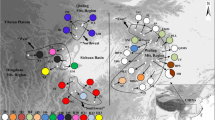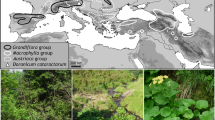Abstract
Dunnia sinensis, a monotypic genus of theRubiaceae endemic to the southeast mainlandChina, is an endangered species due to habitatdestruction over the past decades. Informationon levels and apportionment of geneticvariation across populations and geographicalregions is fundamental to conservation. In thepresent study, we used organelle DNA variationand nested phylogeographic analyses to test theisolation-by-distance model in this specieswith wind-mediated seed-dispersal and todistinguish ongoing gene flow from historicalprocesses. As expected, low levels of geneticvariation were detected at the ribosomal ITSregion of mtDNA (θ = 0.0019± 0.0002) and the atpB-rbcLintergenic spacer of cpDNA (θ =0.0022 ± 0.0009) in the rare species. Sixand seven haplotypes of mt- and cpDNA wereidentified from 125 individuals, respectively,according to the reconstructed neighbor-joiningtrees. Both data sets suggested consistentphylogenies that recovered two differentiatedlineages corresponding to western (Yangchun)and eastern (four others populations) portionsof the range. Hierarchical analyses of themolecular variance (AMOVA) of mt- and cpDNAindicated that molecular variance wasattributable to the difference between regions(Φct = 0.911 and 0.771 for mt- and cpDNA,respectively) in D. sinensis. Based ongeographic distributions of haplotypes in thehaplotype networks, significant geneticdifferentiation between the two geographicregions, which can be seen as evolutionarilyconservation units, was associated withhistorical fragmentation. In contrast, limitedgene flow with occasional long-range dispersalshaped the apportionment of organelle DNAalleles among populations of the easternregion, within which two incompletely isolatedphylogeographic groups can be recognized asconservation units for management.
Similar content being viewed by others
References
Bossart JL, Prowell DP (1998) Genetic estimates of population structure and gene flow, limitations, lessons and new directions. Trends in Ecology and Evolution, 13, 202–206.
Caron H, Dumas S, Marque G, Messier C, Bandou E, Petit RJ, Kremer A (2000) Spatial and temporal distribution of chloroplast DNA polymorphism in a tropical tree species. Molecular Ecology, 9, 1089–1098.
Chao S, Sederoff R, Levings III CS (1984) Nucleotide sequence and evolution of the 18S ribosomal RNA gene in maize mitochondria. Nucleic Acids Research, 12, 6629–6644.
Chiang TY (2000) Lineage sorting accounting for the disassociation between chloroplast and Mictochondrial lineages in oaks of southern France. Genome, 43, 1–5.
Chiang TY, Schaal BA (1999) Phylogeography of North American populations of the moss species Hylocomium splendens based on the nucleotide sequence of internal transcribed spacer 2 of nuclear ribosomal DNA. Molecular Ecology, 8, 1037–1042.
Chiang TY, Schaal BA, Peng CI (1998) Universal primers for amplification and sequencing a noncoding spacer between atpB and rbcL genes of chloroplast DNA. Botanical Bulletin of Academia Sinica, 39, 245–250.
Chiang TY, Chiang YC, Chen YJ, Chou CH, Havanond S, Hong TN, Huang S (2001) Phylogeography of Kandelia candel in east Asiatic mangroves based on nucleotide variation of chloroplast and mitochondrial DNAs. Molecular Ecology, 10, 2697–2710.
Crandall KA, Templeton AR (1993) Empirical tests of some predictions from coalescent theory with applications to intraspecific phylogeny reconstruction. Genetics, 134, 959–969.
Donnelly P, Tavare S (1986) The ages of alleles and a coalescent. Advances in Applied Probability, 18, 1–19.
Dumolin-Lapegue S, Demesure B, Fineschi S, Le Corre V, Petit RJ (1997) Phylogeographic structure of the white oaks throughout the European continent. Genetics, 146, 1475–1487.
Dumolin-Lapègue S, Pemonge MH, Petit RJ (1998) Association between chloroplast and mitochondrial lineages in oaks. Molecular Biology and Evolution, 15, 1321–1331.
Desplanque BF, Viard J, Bernard D, Forcioli P, Saumitou-Laprade J, Cuguen H, van Dijk H (2000) The linkage disequilibrium between chloroplast DNA and mitochondrial DNA haplotypes in Beta vulgaris ssp. maritima (L.), the usefulness of both genomes for population genetic studies. Molecular Ecology, 9, 141–154.
El Mousadik A, Petit RJ (1996) Chloroplast DNA phylogeography of the argan tree of Morocco. Molecular Ecology, 5, 547–555.
Excoffier L (1993) Analysis of Molecular Variance. Version 1.5.5. Genetics and Biometry Laboratory, University of Geneva.
Excoffier L, Smouse PE (1994) Using allele frequencies and geographic subdivision to reconstruct gene trees within a species, molecular variance parsimony. Genetics, 136, 343–359.
Excoffier L, Smouse PE, Quattro JM (1992) Analysis of molecular variance inferred from metric distances among DNA haplotypes, Application to human mitochondrial DNA restriction data. Genetics, 131, 479–491.
Felsenstein J (1985) Confidence limits on phylogenies, an approach using the bootstrap. Evolution, 39, 783–791.
Fauron CMR, Moore B, Casper M (1995) Maize as a model on higher plant mitochondrial genome plasticity. Plant Science, 112, 11–32.
Fu LG (1992) The Red Book of Chinese Plants – Rare and Endangered Plants. Science Press, Beijing.
Ge XJ (1998) The identity of Dunnia assamica (Hook. f.) Ridsd. (Rubiaceae). Journal of Tropical and Subtropical Botany, 6, 47–48.
Golding GB (1987) The detection of deleterious selection using ancestors inferred from a phylogenetic history. Genetic Research, 49, 71–82.
Harris SA, Ingram R (1991) Chloroplast DNA and biosystematics, the effects of intraspecific diversity and plasmid transmission. Taxon, 40, 393–421.
Hewitt GM (1996) Some genetic consequences of ice ages, and their role in divergence and speciation. Biological Journal of Linnean Society, 58, 247–276.
Hewitt GM (1999) Post-glacial re-colonization of European biota. Biological Journal of Linnean Society, 68, 247–276.
Hillis DM, Bull JJ (1993) An empirical test of bootstrapping as a method assessing confidence in phylogenetic analysis. Systematic Biology, 41, 182–192.
Huang S, Chiang YC, Schaal BA, Chou CH, Chiang TY (2001) Organelle DANs phylogeography of Cycas taitungensis, a relict species in Taiwan. Molecular Ecology, 10, 2669–2681.
Jukes TH, Cantor CR (1969) Evolution of protein molecules. In: Mammalian Protein Metabolism (ed. Munroled HN), pp. 31–132. Academic Press, New York.
Kimura M (1980) A simple method for estimating evolutionary rates of base substitutions through comparative studies of nucleotide sequences. Journal of Molecular Evolution, 16, 111–120.
King RA, Ferris C (1998) Chloroplast DNA phylogeography of Alnus glutinosa (L.) Gaertn. Molecular Ecology, 7, 1151–1161.
Kumar S, Tamura K, Nei M (1993) MEGA, Molecular Evolutionary Genetics Analysis. Version 1.01. The Pennsylvania State University, University Park, PA 16802.
Lu SY, Peng CI, Cheng YP, Hong KH, Chiang TY (2001) Chloroplast DNA phylogeography of Cunninghamia konishii (Cupressaceae), an endemic conifer of Taiwan. Genome, 44, 797–807.
Luo H, van Coppenolle B, Seguin M, Boutry M (1995) Mitochondrial DNA polymorphism and phylogenetic relationships in Hevea brasiliensis. Molecular Breeding, 1, 51–63.
Manicacci D, Couvet D, Belhassen E, Gouyon PH, Atlan A (1996) Founder effects and sex ratio in the gyndioeciuos Thymus vulgaris L. Molecular Ecology, 5, 63–72.
Maskas SD, Cruzan MB (2000) Patterns of intraspecific diversification in the Piriqueta caroliniana complex in southeastern North America and Bahamas. Evolution, 54, 815–827.
Moritz C (1994) Defining ‘Evolutionarily Significant Units’ for conservation. Trends in Ecology and Evolution, 9, 373–375.
Murray MG, Thompson WF (1980) Rapid isolation of high molecular weight DNA. Nucleic Acids Research, 8, 4321–4325.
Nei M, Tajima F (1983) Maximum likelihood estimation of the number of nucleotide substitutions from restriction sites data. Genetics, 105, 207–217.
Posada D, Crandall KA, Templeton AR (2000) GeoDis, a program for the cladistic nested analysis of the geographical distribution of genetic haplotypes. Molecular Ecology, 9, 487–488.
Ridsdale CE (1978) The taxonomic position of Dunnia (Rubiaceae). Blumea, 24, 367–368.
Ronfort J, Saumitou-Laprade P, Cuguen J, Couvet D (1995) Mitochondrial DNA diversity and male sterility in natural populations of Daucus carota ssp carota. Theoretical Applied Genetics, 91, 150–159.
Rozas J, Rozas R (1999) DnaSP version 3, an integrated program for molecular population genetics and molecular evolution analysis. Bioinformatics, 15, 174–175.
Schaal BA, Olsen KM (2000) Gene genealogies and population variation in plants. Proceedings of National Academy of Sciences of the United States of America, 97, 7024–7029.
Schaal BA, Hayworth DA, Olsen KM, Rauscher JT, Smith WA (1998) Phylogeographic studies in plants, problems and prospects. Molecular Ecology, 7, 465–474.
Schnabel A, Asmussen JA (1989) Definition and properties of disequilibrium within nuclear-mitochondrial-chloroplast and other nuclear-dicytoplasmic systems. Genetics, 123, 199–215.
Senda M, Onodera Y, Mikami T (1998) Recombination events across the atpA-associated repeated sequences in the mitochondrial genomes of beets. Theoretical and Applied Genetics, 96, 964–968.
Slatkin M (1993) Isolation by distance in equilibrium and nonequilibrium populations. Evolution, 47, 264–279.
Stern DB, Palmer JD (1984) Recombination sequences in plant mitochondrial genomes, diversity and homologies to known mitochondrial genes. Nucleic Acids Research, 12, 6141–6157.
Templeton AR (1998) Nested clade analyses of phylogeographic data, Testing hypotheses about gene flow and population history. Molecular Ecology, 7, 381–397.
Templeton AR, Routman E, Phillips CA (1995) Separating population structure from population history, a cladistic analysis the geographical distribution of mitochondrial DNA haplotypes in the tiger salamander, Ambystoma tigrinum. Genetics, 140, 767–782.
Whitlock MC, MaCauley D (1999) Indirect measures of gene flow and migration, Fst ≠ 1/(4Nm + 1). Heredity, 82, 117–125.
Xia X (1999) Data Analysis in Molecular Biology and Evolution. Version 3. 5. 19. Department of Ecology and Biodiversity, University of Hong-Kong.
Yesodi V, Izhar S, Hauschner H, Tabib Y, Firon N (1997) Homologous recombination invloving cox2 is responsible for a mutation in the cmS-specific mitochondrial locus of Petunia. Molecular & General Genetics, 255, 106–114.
Author information
Authors and Affiliations
Corresponding author
Rights and permissions
About this article
Cite this article
Ge, XJ., Chiang, YC., Chou, CH. et al. Nested clade analysis of Dunnia sinensis (Rubiaceae), a monotypic genus from China based on organelle DNA sequences. Conservation Genetics 3, 351–362 (2002). https://doi.org/10.1023/A:1020579617678
Issue Date:
DOI: https://doi.org/10.1023/A:1020579617678




